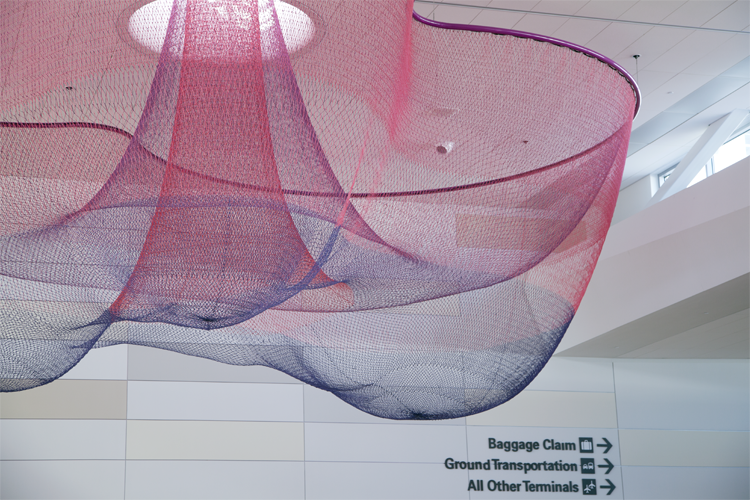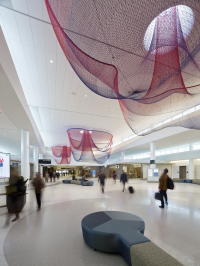Airport design: should they be dull and technical or fun and enjoyable?
10/12/2015

Airports are in transition, in a shift from the passenger process of getting passengers on and off planes, to passenger service: providing a user-friendly, comfortable travel experience. Occasionally airports are mistakenly called shopping malls, but even the greatest of airports are not quite there yet. They are carefully balanced urban places which provide many qualities of a city, rather than being solely isolated spots where travellers disappear into thin air for a few hours – literally.
Airports came to fruition in the US much earlier than elsewhere in the world, and new airports began to emerge further east over the years, first in Europe and then in Asia where there was a greater focus on lifestyle, entertainment and the travel experience as a whole. Changing the basic infrastructure of airports is just as challenging for airport operators as the debate around a third runway in the south east of England.
Interestingly, in the US, airports seem to be regarded as basic infrastructure requirements, without much or any focus on their commercial revenue. Landside access is dominated by private cars in contrast to the variety of public transport that is available at most European and Asian airports.
Transforming terminal buildings into a different experience is a big task for airport owners and municipalities. It could be that new technologies provide the solution to help integrate digital malls and showrooms for international brands in space-constrained airports.

But there is already a different and sensitive approach in US airports. Charles Marshall, Senior Planning Manager of Asset Management at Hartsfield-Jackson Atlanta International Airport, suggested at a recent conference in Frankfurt, that airports are the ‘world’s first airport eco-district’. This type of bold move to interact with local communities, art and culture, food and entertainment, as well as knowledge-related activities and opportunities for learning could transform airports into cities.
In fact, San Francisco’s airport showcases an Airport Museum, thus revolutionising the airport’s relationship with art. Funded by the City of San Francisco, the museum employs more than 25 staff and consistently refreshes its exhibitions on both air and landside, ranging its presentations from small displays to large scale installations.
If airports begin to learn from each other and understand their value as destinations in their own right, soon civic qualities are sure to dominate in customer friendly environments.
(Photos of San Francisco Airport taken by Becky Borlan and Bruce Damonte and provided by www.echelman.com)
—
‘Deconstructing the passenger terminal’ – hear from Henrik in Cologne
Join and share my views at Passenger Terminal EXPO in Cologne
Day 2, 16 March 1.45pm at Airport Cities & Transport Connections
In response to the need to rethink the economy of airports within an increasingly commercialised and competitive environment passenger movement pattern are changing as passenger expectations of a seamless journey from home to plane increase.
Cranfield University will present its research support for airports in their further transition from enclosed, isolated landing strips to inviting, 24/7 urban high streets. Inspired by ‘thinking as the customer first’, the presentation provocatively dissolves the classic terminal by breaking down boundaries between the airport and the city in response to future passenger expectations: plug and go, pods to live in, etc. Committed to cultural and societal change, airports will focus on service culture and process-based facilities to offer a different experience.
Categories & Tags:
Leave a comment on this post:
You might also like…
Automotive Engineering: From student to hypercar innovation at Rimac
We sat down with recent graduate Thomas Perrin, to discuss how his year on the MSc in Automotive Engineering at Cranfield University propelled him from the lecture hall directly into the ...
What this year at Cranfield really meant to me
Every Cranfield journey is unique. In this alumni reflection, Zachea Scicluna shares what her year at Cranfield truly meant, from facing uncertainty to gaining hands-on experience in industry-backed projects. I’ve been reflecting (and delaying) ...
Preparing for assignments and exams?
Sorry! We know it seems a bit mean to mention the exams in January rather than looking forward to the break before it! However, we know many of you will be thinking about your forthcoming ...
Screening for FTSE 100 companies on Bloomberg
So you’re researching an index and need some data on its constituent companies? Bloomberg’s Equity Screening tool makes light work of this, not just for the FTSE, but for indices, exchanges and sectors worldwide. Type EQS ...
Accelerating my future: How Cranfield put me on the fast track to automotive safety innovation
Hello! I’m Michaela Kaiser, and I’m thrilled to share my journey studying abroad. I’m from Calgary, Canada, and I recently graduated from Cranfield’s MSc Automotive Engineering course. My path to Cranfield ...
From Myanmar to Cranfield: My path to Renewable Energy
As someone who is passionate about sustainability, my career goal is to build a path in the renewable energy sector. My aspirations comes from the benefits of developing sustainable energy sources and ensuring energy ...






